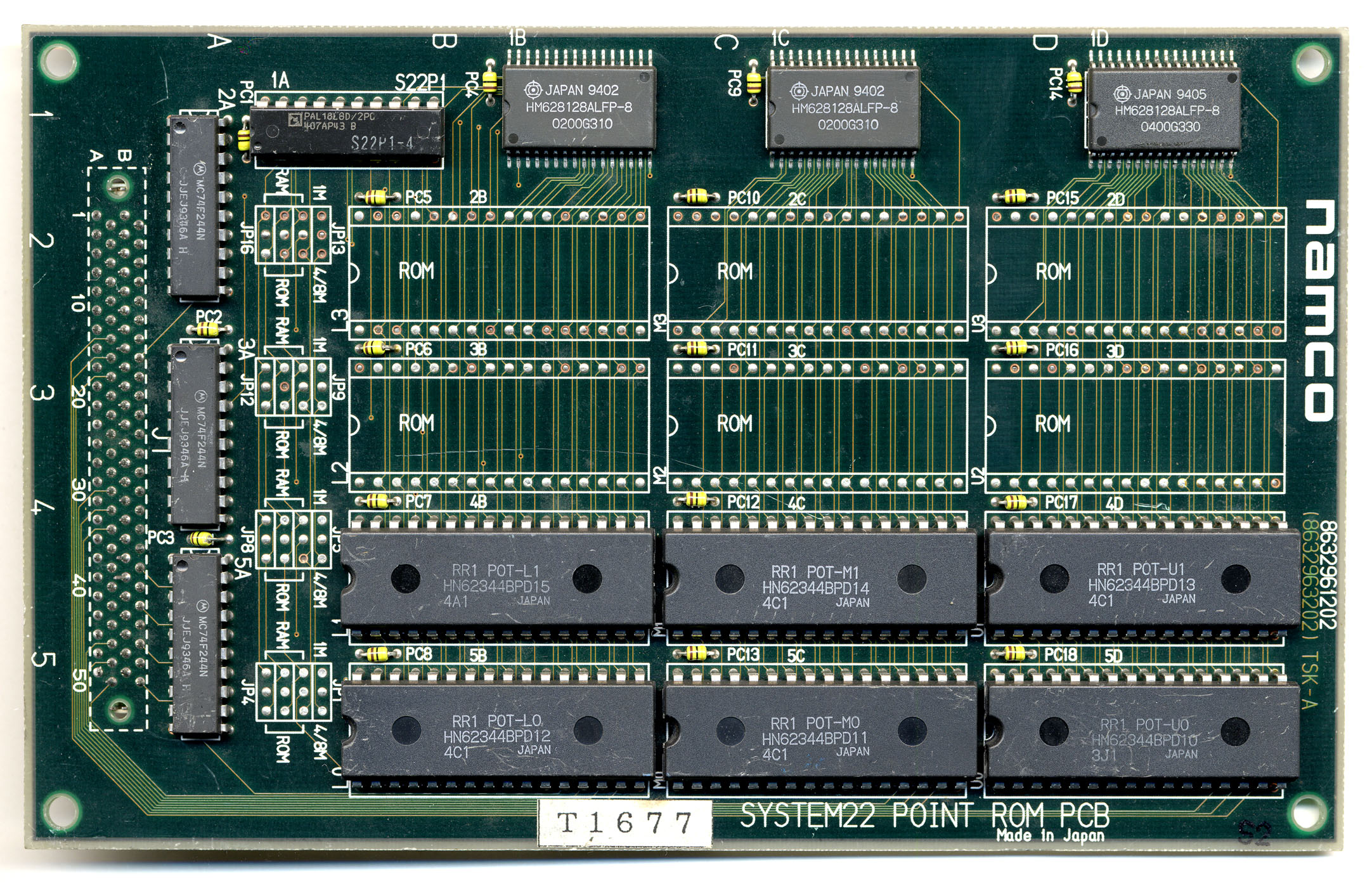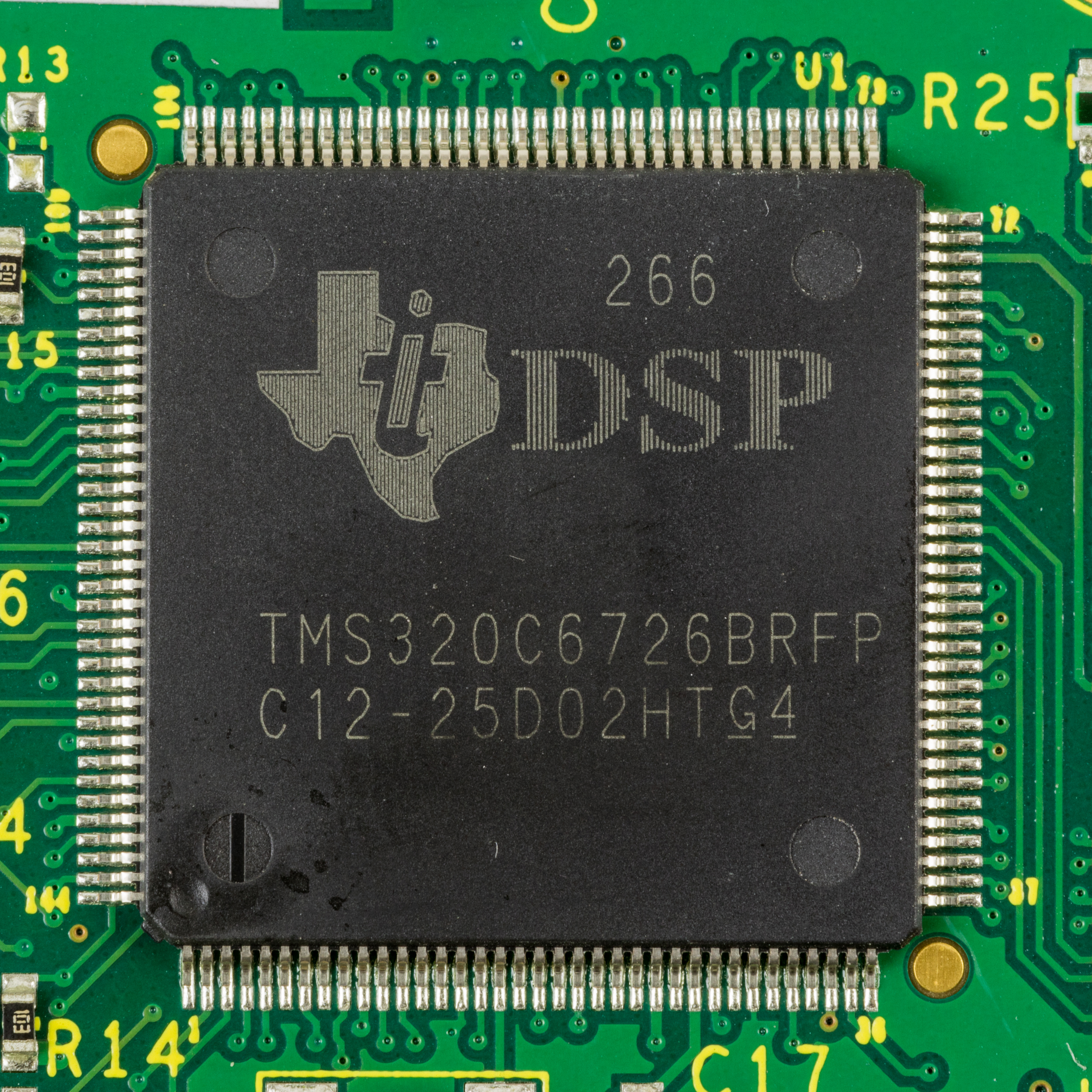|
Super System 22
The Namco System 22 is the successor to the Namco System 21 arcade system board. It debuted in 1992 with '' Sim Drive'' in Japan, followed by a worldwide debut in 1993 with ''Ridge Racer''. The System 22 was designed by Namco with assistance from graphics & simulation company Evans & Sutherland. Graphical features include texture mapping, Gouraud shading, transparency effects, and depth cueing, thanks to the Evans & Sutherland 'TR3' chip/chipset, which stands for: Texture Mapping, Real-Time, Real-Visual, Rendering System. The main CPU provides a scene description to the TR3 graphics processing unit and a bank of DSP chips which perform 3D calculations. A variant of the system, called the Super System 22, was released in 1995. The hardware was largely similar to the System 22, but with a slightly higher polygon rate and more special effects possible. System 22 Specifications *Main CPU: Motorola 68020 32-bit @ 24.576 MHz *DSP: 2x Texas Instruments TMS32025 @ 49.1 ... [...More Info...] [...Related Items...] OR: [Wikipedia] [Google] [Baidu] |
Polygon
In geometry, a polygon () is a plane figure that is described by a finite number of straight line segments connected to form a closed ''polygonal chain'' (or ''polygonal circuit''). The bounded plane region, the bounding circuit, or the two together, may be called a polygon. The segments of a polygonal circuit are called its '' edges'' or ''sides''. The points where two edges meet are the polygon's '' vertices'' (singular: vertex) or ''corners''. The interior of a solid polygon is sometimes called its ''body''. An ''n''-gon is a polygon with ''n'' sides; for example, a triangle is a 3-gon. A simple polygon is one which does not intersect itself. Mathematicians are often concerned only with the bounding polygonal chains of simple polygons and they often define a polygon accordingly. A polygonal boundary may be allowed to cross over itself, creating star polygons and other self-intersecting polygons. A polygon is a 2-dimensional example of the more general polytope in any number ... [...More Info...] [...Related Items...] OR: [Wikipedia] [Google] [Baidu] |
Ace Driver
is a 1994 racing game, racing arcade game developed and published by Namco. The player controls a Formula One racer, with the objective being to complete three laps of a race course and to avoid a collision with opponents and other obstacles. Three difficulty levels are available, as is a mode to enable a gear shift. Similar to Namco's own ''Final Lap'' series, the arcade cabinet can be linked together with another unit to enable eight-person multiplayer. It ran on the Namco System 22 arcade hardware. ''Ace Driver'' was designed by Tatsuro Okamoto, his known for his work on the classic arcade game ''Metro-Cross'' (1985). He was assisted by ''Pole Position'' designer Shinichiro Okamoto. The game was a widespread success, winning the "Best Coin-Operated Game" award at the 76th Annual IAAPA tradeshow in November 1994. Critics praised the game's realistic graphics, multiplayer and responsive controls, with some reviewers finding it to be superior than Sega's ''Daytona USA (video game ... [...More Info...] [...Related Items...] OR: [Wikipedia] [Google] [Baidu] |
Namco Aqua Jet
was a Japanese multinational video game and entertainment company, headquartered in Ōta, Tokyo. It held several international branches, including Namco America in Santa Clara, California, Namco Europe in London, Namco Taiwan in Kaohsiung, and Shanghai Namco in mainland China. Namco was founded by Masaya Nakamura on June 1, 1955, as beginning as an operator of coin-operated amusement rides. After reorganizing to Nakamura Seisakusho Co., Ltd. in 1959, a partnership with Walt Disney Productions provided the company with the resources to expand its operations. In the 1960s, it manufactured electro-mechanical arcade games such as the 1965 hit ''Periscope''. It entered the video game industry after acquiring the struggling Japanese division of Atari in 1974, distributing games such as '' Breakout'' in Japan. The company renamed itself Namco in 1977 and published '' Gee Bee'', its first original video game, a year later. Among Namco's first major hits was the fixed shooter ''Gala ... [...More Info...] [...Related Items...] OR: [Wikipedia] [Google] [Baidu] |
Time Crisis P170312 11
Time is the continued sequence of existence and events that occurs in an apparently irreversible succession from the past, through the present, into the future. It is a component quantity of various measurements used to sequence events, to compare the duration of events or the intervals between them, and to quantify rates of change of quantities in material reality or in the conscious experience. Time is often referred to as a fourth dimension, along with three spatial dimensions. Time has long been an important subject of study in religion, philosophy, and science, but defining it in a manner applicable to all fields without circularity has consistently eluded scholars. Nevertheless, diverse fields such as business, industry, sports, the sciences, and the performing arts all incorporate some notion of time into their respective measuring systems. 108 pages. Time in physics is operationally defined as "what a clock reads". The physical nature of time is addressed ... [...More Info...] [...Related Items...] OR: [Wikipedia] [Google] [Baidu] |
Namco System22 Rave Racer
was a Japanese multinational video game and entertainment company, headquartered in Ōta, Tokyo. It held several international branches, including Namco America in Santa Clara, California, Namco Europe in London, Namco Taiwan in Kaohsiung, and Shanghai Namco in mainland China. Namco was founded by Masaya Nakamura on June 1, 1955, as beginning as an operator of coin-operated amusement rides. After reorganizing to Nakamura Seisakusho Co., Ltd. in 1959, a partnership with Walt Disney Productions provided the company with the resources to expand its operations. In the 1960s, it manufactured electro-mechanical arcade games such as the 1965 hit ''Periscope''. It entered the video game industry after acquiring the struggling Japanese division of Atari in 1974, distributing games such as '' Breakout'' in Japan. The company renamed itself Namco in 1977 and published '' Gee Bee'', its first original video game, a year later. Among Namco's first major hits was the fixed shooter '' Ga ... [...More Info...] [...Related Items...] OR: [Wikipedia] [Google] [Baidu] |
Mitsubishi
The is a group of autonomous Japanese multinational companies in a variety of industries. Founded by Yatarō Iwasaki in 1870, the Mitsubishi Group historically descended from the Mitsubishi zaibatsu, a unified company which existed from 1870 to 1946. The company was disbanded during the occupation of Japan following World War II. The former constituents of the company continue to share the Mitsubishi brand and trademark. Although the group of companies participate in limited business cooperation, most famously through monthly "Friday Conference" executive meetings, they are formally independent and are not under common control. The four main companies in the group are MUFG Bank (the largest bank in Japan), Mitsubishi Corporation (a general trading company), Mitsubishi Electric and Mitsubishi Heavy Industries (both diversified manufacturing companies). History The Mitsubishi company was established as a shipping firm by Iwasaki Yatarō (1834–1885) in 1870 under the name ... [...More Info...] [...Related Items...] OR: [Wikipedia] [Google] [Baidu] |
Texture Mapping
Texture mapping is a method for mapping a texture on a computer-generated graphic. Texture here can be high frequency detail, surface texture, or color. History The original technique was pioneered by Edwin Catmull in 1974. Texture mapping originally referred to diffuse mapping, a method that simply mapped pixels from a texture to a 3D surface ("wrapping" the image around the object). In recent decades, the advent of multi-pass rendering, multitexturing, mipmaps, and more complex mappings such as height mapping, bump mapping, normal mapping, displacement mapping, reflection mapping, specular mapping, occlusion mapping, and many other variations on the technique (controlled by a materials system) have made it possible to simulate near-photorealism in real time by vastly reducing the number of polygons and lighting calculations needed to construct a realistic and functional 3D scene. Texture maps A is an image applied (mapped) to the surface of a shape or polygon. This ... [...More Info...] [...Related Items...] OR: [Wikipedia] [Google] [Baidu] |
Graphics Processing Unit
A graphics processing unit (GPU) is a specialized electronic circuit designed to manipulate and alter memory to accelerate the creation of images in a frame buffer intended for output to a display device. GPUs are used in embedded systems, mobile phones, personal computers, workstations, and game consoles. Modern GPUs are efficient at manipulating computer graphics and image processing. Their parallel structure makes them more efficient than general-purpose central processing units (CPUs) for algorithms that process large blocks of data in parallel. In a personal computer, a GPU can be present on a video card or embedded on the motherboard. In some CPUs, they are embedded on the CPU die. In the 1970s, the term "GPU" originally stood for ''graphics processor unit'' and described a programmable processing unit independently working from the CPU and responsible for graphics manipulation and output. Later, in 1994, Sony used the term (now standing for ''graphics processing unit'' ... [...More Info...] [...Related Items...] OR: [Wikipedia] [Google] [Baidu] |
Texas Instruments TMS320
Texas Instruments TMS320 is a blanket name for a series of digital signal processors (DSPs) from Texas Instruments. It was introduced on April 8, 1983 through the TMS32010 processor, which was then the fastest DSP on the market. The processor is available in many different variants, some with fixed-point arithmetic and some with floating point arithmetic. The TMS320 processors were fabricated on MOS integrated circuit chips, including both NMOS and CMOS variants. The floating point DSP TMS320C3x, which exploits delayed branch logic, has as many as three delay slots. The flexibility of this line of processors has led to it being used not merely as a co-processor for digital signal processing but also as a main CPU. Newer implementations support standard IEEE JTAG control for boundary scan and/or in-circuit debugging. The original TMS32010 and its subsequent variants is an example of a CPU with a modified Harvard architecture, which features separate address spaces for instruc ... [...More Info...] [...Related Items...] OR: [Wikipedia] [Google] [Baidu] |
32-bit
In computer architecture, 32-bit computing refers to computer systems with a processor, memory, and other major system components that operate on data in 32-bit units. Compared to smaller bit widths, 32-bit computers can perform large calculations more efficiently and process more data per clock cycle. Typical 32-bit personal computers also have a 32-bit address bus, permitting up to 4 GB of RAM to be accessed; far more than previous generations of system architecture allowed. 32-bit designs have been used since the earliest days of electronic computing, in experimental systems and then in large mainframe and minicomputer systems. The first hybrid 16/32-bit microprocessor, the Motorola 68000, was introduced in the late 1970s and used in systems such as the original Apple Macintosh. Fully 32-bit microprocessors such as the Motorola 68020 and Intel 80386 were launched in the early to mid 1980s and became dominant by the early 1990s. This generation of personal computers coincided ... [...More Info...] [...Related Items...] OR: [Wikipedia] [Google] [Baidu] |






